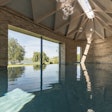





With August here and the dog days of summer upon us, we thought it might fun to take a trip to the beach. Our destination: the legendary surf spot known as Pleasure Point in Santa Cruz, Calif.
Why there, you ask? In addition to its status as one of the greatest aquatic environments found in North America, Pleasure Point recently underwent a massive geological stabilization project featuring gargantuan seawall structures that locals demanded look realistic, a project that pushed the limits of faux rockwork both in terms of sheer scale and attention to detail.
In 2007, after years of battling crumbing cliffs along the scenic east side of Santa Cruz, the city gave the green light to 1,200 feet of seawall engineered to stabilize the cliffs and protect homes threatened by cliff erosion while also enhancing beach access. The plan, and its near $7 million dollar price tag, was long opposed by the local chapter of the Surfrider Foundation, which feared the work would disrupt the site’s stunning natural beauty. Eventually, however, even ardent environmentalists conceded the project was in the best interest of the community and would do no harm to the precious marine resources.
Beyond stabilizing the cliffs, the ambitious project gained widespread praise for the effort by designers and builders to create seawalls that appear incredibly real.
Led by general contractor Pavex Construction, the project team that also included Drill Tech Drilling and Shoring and 123 Engineering crafted massive reinforced concrete structures that are painstaking detailed and randomly varied in appearance, successfully avoiding any sense of monotony. Taking design cues from regional volcanic cliff formations, the structures include long stretches of shelves and plateaus that happen to be perfect for sunning just above the surf and sand, especially during high tides and big surf conditions. At the far west end, a large, rocky viewing deck extends from a natural promontory directly in front of the largest waves, now a favorite spot for surf photographers.
Atop the cliffs, where breathtaking views of the Monterey Bay sweep to the south, locals and visitors now enjoy new pedestrian and bicycle paths, faux-rock stairwells and multiple seating and scenic viewpoint locations.
Finally, at the west end of the three-quarter-mile-long stretch, a newly renovated Pleasure Point Park features an ingenious decorative concrete shelf system designed for lounging and prepping for the waves. The unique design mimics geo-strata typical of natural formations at low tide. Designed by landscape architect Leslie Stone and executed by local decorative concrete specialist Tom Ralston, the work features a fossilized whalebone molded from a real fossil unearthed at the site, along with shark’s teeth, scallop shells and sand dollars.












































